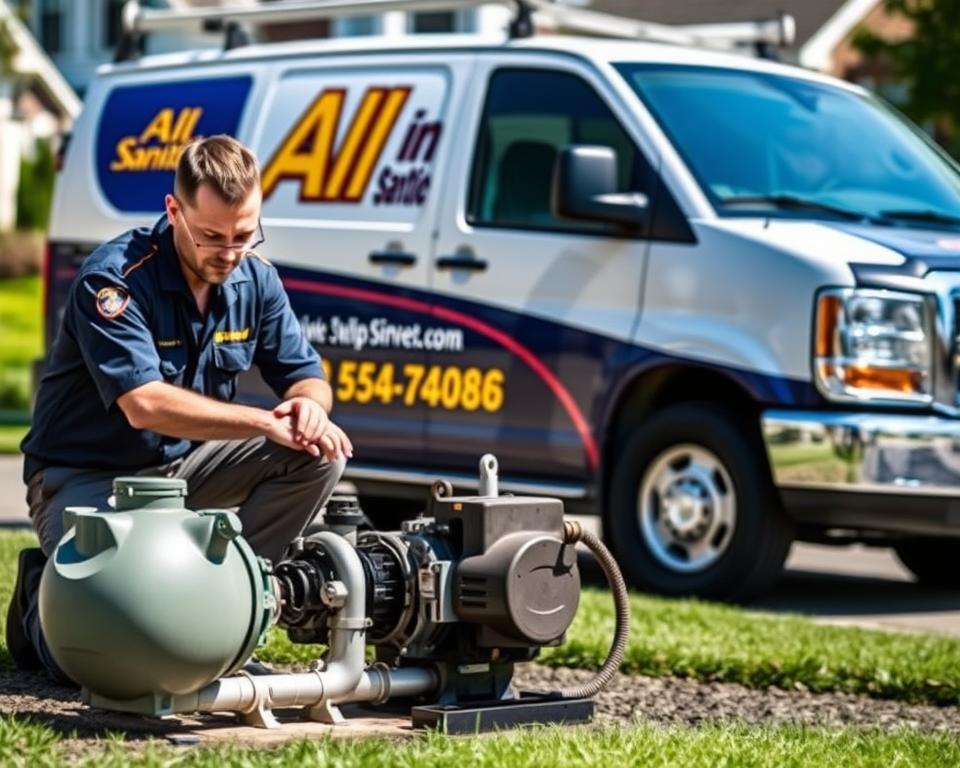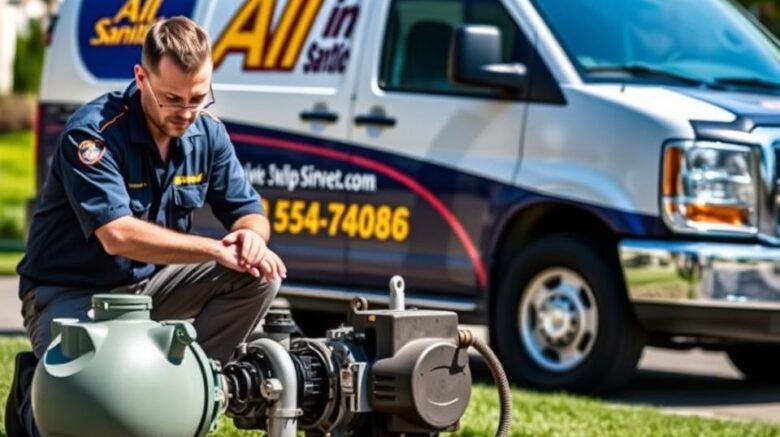Septic Aerator Pump: Complete Guide for Residential Users
Have you ever wondered what powers your aerobic septic system’s efficiency? The Septic air pump is the often-overlooked champion indispensable for your system. In this article, homeowners will acquire practical knowledge on the Septic air pump’s function. It’s critical for a sound, optimized Septic tank.
Appreciating the necessity of a Septic tank air Pump can improve your Septic system’s capabilities using septic tank cleaning services near me. It also protects your real-estate worth and environmental health. This guide will introduce All in Sanitation, a leading Septic industry expert. They’re prepared to serve your Septic aerator Pump requirements.
Essential Insights
- The Septic air Pump is indispensable for oxygen-based Septic setups.
- Properly caring for your Septic system air Pump can improve overall system efficiency.
- Routine inspections prolong the durability of your Septic tank air Pump.
- Choosing the proper Septic aerator Pump is essential for peak operation.
- All in Sanitation offers tailored services for Septic air Pump support.
Understanding Aerobic Septic Solutions
Aerobic Septic systems offer a superior waste treatment method by employing oxygen. This technique features aerobic bacteria living in well-oxygenated environments. These bacteria are faster in decomposing organic matter. With the help of Septic aerator Pumps, these systems ensure a continuous oxygen supply, boosting the waste decomposition process.
These systems shine in decreasing sludge buildup, due to the efficiency of aerobic bacteria. This reduction in solid waste means minimal cleaning and tank Pump-outs is necessary. Additionally, they successfully handle wastewater, resulting in reduced odors. This ensures a better environment for homeowners and the community together.
To make sure these systems run efficiently, it’s necessary to understand the key Septic system components. These include the Septic tank, aeration chamber, and effluent Pump. Each element serves a key function, especially the air Pump. It drives oxygen into the tank, essential for the aerobic bacteria’s efficiency.
Role of the Septic Air Pump
The Septic air Pump is central in the performance of aerobic Septic systems. It functions like the system’s “oxygen source,” pushing the necessary oxygen required. This oxygen allows aerobic bacteria to prosper and decompose waste quickly. If the Pump stops, the system’s capability drops, leading to sludge collection and possible odors.
Such issues can undermine Septic system operations and pose environmental hazards. By acknowledging how important the Septic air Pump is, homeowners can move early. They can keep its optimal function through scheduled service. This avoids failures, reduces costly repairs, and protects the aerobic system’s integrity.
Major Benefits of Using a Septic Air Pump
Utilizing a Septic air Pump significantly boosts the performance of Septic systems. Septic air Pumps are essential as they quicken the decomposition of waste. This is done by oxygenating the treatment process, stimulating aerobic bacteria growth. These bacteria are necessary for proper waste treatment.
They’re also useful in lowering foul smells. Because of more active aerobic processes, waste is treated faster, thus lessening odors. This ensures better surroundings for homeowners.
Another noteworthy benefit is the drop in sludge accumulation. Consequently, tanks require less frequent Pumping, conserving both money and time. Greater processing not only saves costs but also increases the lifespan of the drain field.
Looking after these Pumps correctly means less frequent repair costs and complying with regulatory standards. Thus, the advantages of Septic air Pumps are not only for homeowners. They also enhance environmental health by raising waste management practices.
| Benefit | Description |
|---|---|
| Fast Waste Breakdown | Increased aerobic activity speeds the decomposition process. |
| Minimized Odor Emissions | Improved treatment efficacy results in fewer odors. |
| Reduced Sludge Buildup | Minimal Pumping and maintenance are needed. |
| Extended Drain Field Life | Better treatment translates to a healthier drain field. |
| Cost Savings | Lower risk of repairs and regulatory compliance cost. |

Finding a Suitable Septic Air Pump
Opting for the correct Septic air Pump is key for an effective aerobic system. Homeowners should assess various factors for the perfect selection. The volume of the tank and the airflow requirements matter greatly the Pump’s performance.
To make an informed choice, it’s useful to be aware of the air Pumps available. There are mainly two types: diaphragm Pumps and rotary vane Pumps. Each offers distinct advantages, which should be aligned with your home’s specific needs and how it operates.
Electric efficiency also matters. Opting for a Pump that cuts energy use while delivering the needed airflow can offer significant savings. Help from All in Sanitation specialists can be extremely useful. They confirm the Pump you choose matches your system’s requirements exactly.
Major Kinds of Septic Air Pumps
Homeowners can choose intelligently by recognizing the various Septic air Pumps available. There are mainly two types: diaphragm Pumps and rotary vane Pumps. Each has its specific functions and benefits.
Diaphragm Pumps, known for their hushed operation, are popular for residential Septic systems. They deliver energy efficiency while ensuring stable air output. Their dependable performance matches smaller systems, appealing to many homeowners.
Rotary vane Pumps, however, are designed for bigger or commercial systems. These Pumps deliver higher capacity, necessary for handling bigger loads. Their strong build guarantees efficient operation in large-scale Septic systems.
| Type of Pump | Best Use | Advantages |
|---|---|---|
| Diaphragm Pumps | Residential Systems | Quiet operation, energy-efficient, reliable air flow |
| Rotary Vane Pumps | Larger or Commercial Systems | Powerful performance, high capacity, durable construction |
Recognizing the contrasts in Septic air Pumps is important for upgrades or replacements. Each Pump type offers specific features to satisfy various needs. This ensures best performance for any system.
How to Tell You Need a Septic Air Pump Replacement
Homeowners must look out for Pump failure signs in their Septic systems. Some indicators point towards the need for a Septic air Pump replacement. These support reliable function. Identifying these promptly stops larger issues.
Signs of potential problems include:
- Unusual noises from the Pump, like scraping or trembling, might suggest internal damage.
- A clear lack of air output indicates the Pump isn’t functioning properly, harming efficiency.
- Frequent electrical problems, such as power trips or flickering lights, could point to overloading.
- Visible damage on the Pump unit, with cracks or leaks, needs quick action.
- Bad smells in the yard often signal a compromised Pump, highlighting ineffective effluent aeration.
Finding these signs early avoids costly fixes or total system failure. Scheduling routine inspections makes it easy to catch these issues. It also clarifies if you should get a new Septic air Pump.
Service Tips for Your Septic Air Pump
For an efficient Septic air Pump, periodic care is essential. This ensures that that your system runs well. Homeowners can apply several simple care strategies for optimal results.
Bi-annually, carry out a detailed inspection for wear or damage. It is also crucial to swap out the filters as recommended. This stops clogs that could lower efficiency.
The Pump should stand on a firm base to reduce vibrations, which could wear it over time. A protective cover is critical too. It shields against debris and water, maintaining the Pump’s functionality.
Regular servicing can greatly extend the life of your Pump. In turn, this supports the Septic system’s performance overall.
| Maintenance Task | Frequency | Benefits |
|---|---|---|
| Inspect Pump for damage | Every 6 months | Identifies issues early |
| Replace filters | As needed | Keeps performance up |
| Check surface stability | Annually | Minimizes shake |
| Clear debris around Pump | Monthly | Avoids obstruction |
Installing Your Septic Air Pump
Accurate installation of your Septic air Pump is vital for its efficient operation. Initially, find a reliable, moisture-free area for placement. The chosen spot should securely accommodate the Pump’s weight easily.
To successfully mount your Pump on your own, follow the following guidelines:
- Assemble all necessary items, including the Pump, a power source, and hose fittings.
- Thoroughly review the manufacturer’s guidelines before commencing your installation.
- Make sure every connection is secure to stop air leaks that impact performance.
- After assembly, complete a test to ensure the system works as intended.
If the installation process appears difficult, call All in Sanitation. Their professionals can avoid common errors, making sure your setup meets mandatory safety requirements.
Benefits of Choosing All in Sanitation for Your Septic Air Pump Needs
When choosing a Septic service provider, the choice is key. All in Sanitation separates itself by supplying dependable Septic air Pumps. They address different homeowner requirements with a wide selection of premium products. This ensures customers discover an exact match for their Septic systems.
What really sets apart All in Sanitation is not solely their large product lineup. Their dedication to exceptional customer service is also critical. Homeowners get knowledgeable support, guiding them towards trusted Septic solutions. This collaboration is important to adapt each solution to match specific needs.
All in Sanitation also emphasizes aftercare to guarantee lasting satisfaction. Their commitment continues beyond the initial sale. They offer ongoing support to preserve Septic systems running smoothly for the foreseeable future.
Expense Overview for Septic Air Pumps
Appreciating the price factors linked to Septic air Pumps is key for homeowners with aerobic Septic systems. Initially, one faces the buy-in cost, which includes the Pump and needed accessories. Installation expenses change, depending on the system’s complexity and any changes required.
Ongoing upkeep forms an additional cost layer. Consistent assessments can ward off bigger issues, which can mean savings. Homeowners should plan for Septic maintenance to retain the Pump’s effectiveness and service life. Such planning avoids expensive repairs later on, demonstrating the value of proactive maintenance.
| Cost Component | Average Cost Range |
|---|---|
| Septic Air Pump | $500 – $1,200 |
| Installation | $300 – $800 |
| Annual Maintenance | $150 – $400 |
| Potential Repair Costs | $1,000 – $5,000 |
Separating Septic air Pump expenses into specific parts assists homeowners in budgeting. This comprehensive approach secures the system’s steady performance and their peace of mind.
To Conclude
For homeowners with aerobic Septic systems, caring for Septic setups is vital. The proper Septic air Pump optimizes waste processing and prolongs your system’s life. Scheduling routine maintenance and promptly addressing issues avoids costly fixes and disruptions.
Picking a Septic air Pump demands deliberation. This guide covered how to select effectively about installation and replacement. With All in Sanitation’s support, you can navigate your Septic systems’ complexities confidently.
Maintaining your Septic air Pump promotes your system’s operation and durability. It ensures a trouble-free and effective operation over time. Don’t forget, your home’s wastewater management relies heavily on proper care.
